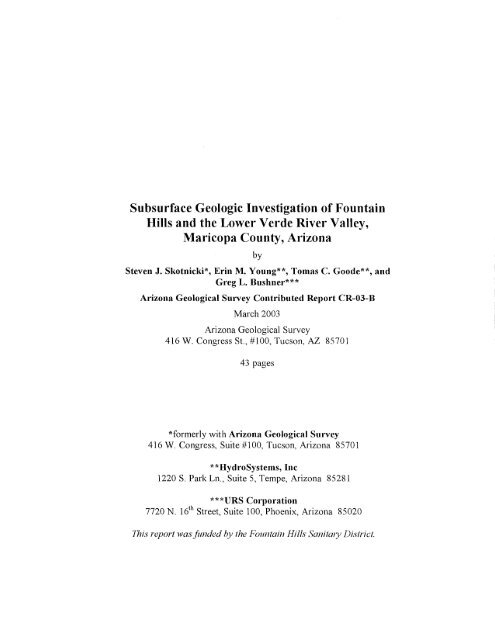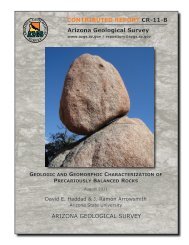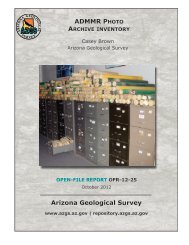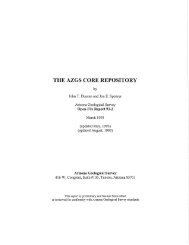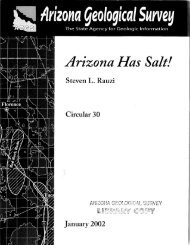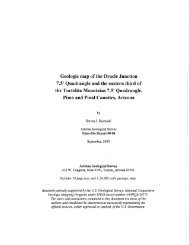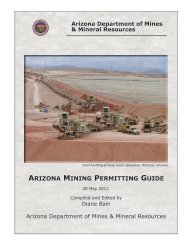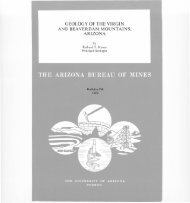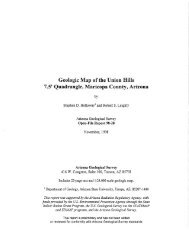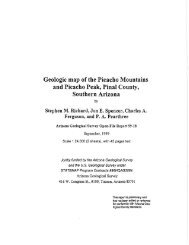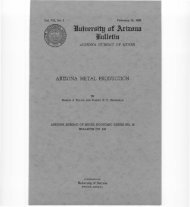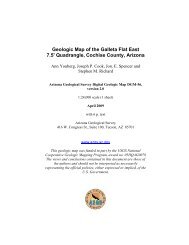Subsurface Geologic Investigation of Fountain Hills - AZGS ...
Subsurface Geologic Investigation of Fountain Hills - AZGS ...
Subsurface Geologic Investigation of Fountain Hills - AZGS ...
You also want an ePaper? Increase the reach of your titles
YUMPU automatically turns print PDFs into web optimized ePapers that Google loves.
<strong>Subsurface</strong> <strong>Geologic</strong> <strong>Investigation</strong> <strong>of</strong> <strong>Fountain</strong><br />
<strong>Hills</strong> and the Lower Verde River Valley,<br />
Maricopa County, Arizona<br />
by<br />
Steven J. Skotnicki*, Erin M. Young**, Tomas C. Goode**, and<br />
Greg L. Bushner* * *<br />
Arizona <strong>Geologic</strong>al Survey Contributed Report CR-03-B<br />
March 2003<br />
Arizona <strong>Geologic</strong>al Survey<br />
416 W. Congress St., #100, Tucson, AZ 85701<br />
43 pages<br />
*formerly with Arizona <strong>Geologic</strong>al Survey<br />
416 W. Congress, Suite #100, Tucson, Arizona 85701<br />
* * HydroSystems, Inc<br />
1220 S. Park Ln., Suite 5, Tempe, Arizona 85281<br />
***URS Corporation<br />
7720 N. 16 th Street, Suite 100, Phoenix, Arizona 85020<br />
I'Ms report wasfu17ded by the FOllntain <strong>Hills</strong> SallitalY Districl.
INTRODUCTION<br />
The Lower Verde River Valley is a discrete groundwater basin separated from the<br />
Phoenix basin by the McDowell Mountains and bounded on all sides by bedrock, (see<br />
figure 1). The basin formed during the late Miocene to Pliocene in response to crustal<br />
extension during the Basin and Range orogeny. The perennial Verde River flows<br />
southward across the valley from Bartlett Dam in the north to its confluence with the Salt<br />
River on the east side <strong>of</strong> Mount McDowell in the south. Two major ephemeral streams<br />
join the Verde River within the valley. Camp Creek drains the northwest part <strong>of</strong> the basin<br />
near Humbolt Mesa and enters the Verde River at Needle Rock. Sycamore Creek drains<br />
the northeast part <strong>of</strong> the basin, on the west side <strong>of</strong> the Mazatzal Mountains, and enters the<br />
Verde just north <strong>of</strong> Fort McDowell. Both streams typically show no surface flow except<br />
during periods <strong>of</strong> extended and heavy rainfall.<br />
The purpose <strong>of</strong> this study is to try to delineate the subsurface geology beneath the<br />
Town <strong>of</strong> <strong>Fountain</strong> <strong>Hills</strong> and the Lower Verde River Valley in order to place constraints<br />
on the shape and distribution <strong>of</strong> the groundwater reservoir(s). The surface geology was<br />
compiled mostly from recent geologic mapping by workers at the Arizona <strong>Geologic</strong>al<br />
Survey (see previous work section below) and by students from Arizona State University.<br />
The subsurface geology was interpreted from examination <strong>of</strong> over two hundred well logs<br />
obtained from the Arizona Department <strong>of</strong> Water Resources, combined with structural<br />
interpretations based on observed surface geology and geophysical data.<br />
The U.S. Army established Fort McDowell on September 7, 1865 to protect<br />
settlers against Apache Indian attacks (McDonald and Padgett, 1945). After 15 years the<br />
fort was abandoned in 1890 and established as an Indian reservation in 1891. The Fort<br />
McDowell Indian reservation is a strip <strong>of</strong> land about four miles wide and ten miles long<br />
centered on the Verde River that occupies the south-central part <strong>of</strong> the valley. East <strong>of</strong> the<br />
reservation is the Tonto National Forest. To the south is the Salt River Pima/Maricopa<br />
Indian Community. To the west is the Town <strong>of</strong> <strong>Fountain</strong> <strong>Hills</strong> and a mix <strong>of</strong> State, federal,<br />
and private land. The developments <strong>of</strong> Tonto Verde and Rio Verde have sprung up within<br />
the last ten years on the north side <strong>of</strong> the Fort McDowell Indian Reservation.<br />
<strong>Fountain</strong> <strong>Hills</strong> Blvd. provides good north-south access to the center <strong>of</strong> the valley<br />
and connects with the east-west Rio Verde Road on the north side <strong>of</strong>the valley. Rio
Valley Road turns into Dynamite Road on the west side <strong>of</strong> the divide near Pinnacle Peak.<br />
State Route 87 slices east-west across the southern and eastern parts <strong>of</strong> the basin. The<br />
development <strong>of</strong> Goldfield Heights sits on the east side <strong>of</strong> the Verde River, southeast <strong>of</strong><br />
Adams Mesa and north <strong>of</strong> State Route 87. The area between State Route 87 and Bartlett<br />
Dam is the least accessible area in the Lower Verde River valley and can generally only<br />
be accessed from dirt roads on the east side <strong>of</strong> Adams Mesa and the graded road to<br />
Sugarloaf Mountain.<br />
PREVIOUS WORK<br />
Christenson (1975), Welsch (1977), Couch (1981), and Christenson et aI., (1978)<br />
mapped the bedrock and general surficial geology <strong>of</strong> the McDowell Mountains. Pewe et<br />
aI., (1985), and Kenny (1986) mapped the bedrock geology <strong>of</strong> the northern end <strong>of</strong> the<br />
McDowell Mountains and the pediment north <strong>of</strong> Pinnacle Peak. Skotnicki et aI., (1997)<br />
and Leighty et aI., (1997) mapped the bedrock and surficial geology in the Cave Creek<br />
Carefree area. Skotnicki (1996b) mapped the Bartlett Dam quadrangle. The bedrock on<br />
the east side <strong>of</strong> the basin was mapped by Skotnicki (1992) and later by Skotnicki and<br />
Leighty (1997a, 1998). To the south Skotnicki and Leighty (1997b) mapped the Stewart<br />
Mountain quadrangle and Skotnicki (1995) mapped the area between the Town <strong>of</strong><br />
<strong>Fountain</strong> <strong>Hills</strong> and Mount McDowell. Skotnicki (1996a) mapped the Fort McDowell<br />
quadrangle and part <strong>of</strong> the McDowell Peak quadrangle in the center <strong>of</strong> the valley.<br />
McDonald and Padgett (1945) were the first to study the hydrology <strong>of</strong> the basin in<br />
detail. They described the history <strong>of</strong> water usage in the area and the general geology.<br />
Thomsen and Schumann (1968) studied the water resources <strong>of</strong> the Sycamore Creek<br />
watershed and also described the general geology. Kokalis (1971) and Pope (1974) made<br />
detailed studies <strong>of</strong> the Salt and Verde River terraces, respectfully, and interpreted the<br />
provenance <strong>of</strong> the river cobbles. Pewe (1978, 1987) described terraces along the lower<br />
Salt and Verde Rivers, noting their height above the river, the degree <strong>of</strong> calcium<br />
carbonate cementation, and their downstream-converging longitudinal pr<strong>of</strong>iles. Morrison<br />
(1985) provided brief descriptions <strong>of</strong> these terraces and correlated them to other terrace<br />
sequences in central Arizona. Camp (1986) produced a series <strong>of</strong> soil maps, which<br />
includes the Lower Verde River valley. Cooley (1973) produced a map showing the<br />
3
distribution and estimated thickness <strong>of</strong> alluvial deposits in the Phoenix area, including the<br />
Lower Verde River valley.<br />
Deslauriers (1977) made a detailed gravity and magnetic survey in the Lower<br />
Verde River Valley. His work was later incorporated into state-wide gravity maps<br />
produced by Lysonski et aI., (1981). Harris (1997) measured the uranium distribution in<br />
the Cave Creek-Carefree area.<br />
There are several investigators that researched the hydrology specific to the Town<br />
<strong>of</strong> <strong>Fountain</strong> <strong>Hills</strong>. Manera & Associates (1974) collected aquifer test data on wells in this<br />
area. These data were reviewed by Nemecek and Briggs (1975) to further refine the<br />
aquifer test data results in support <strong>of</strong> an Assured Water Supply for the Town. There are<br />
many others authors that conducted work specific to the Town <strong>of</strong> <strong>Fountain</strong> <strong>Hills</strong><br />
including Turner (1968) who provided preliminary research regarding the water resources<br />
<strong>of</strong> the area and DCI, Inc. (1995) who supplied a hydrologic report in support <strong>of</strong> an<br />
Assured Water Supply. Manera & Associates (1973, 1974, and 1975a) wrote reports on<br />
the geology and hydrology <strong>of</strong> the <strong>Fountain</strong> <strong>Hills</strong> area. Halpenny (1975) provided an<br />
analysis <strong>of</strong> the evaporative losses from the lake and the fountain in <strong>Fountain</strong> Lake. There<br />
were several geophysical analysis conducted and reported by Ward (1975), Group Seven<br />
(1976), and Harshbarger and Associates (1975). Manera & Associates (1975b) published<br />
a review <strong>of</strong> the aforementioned reports. Most recently HydroSystems, Inc. (HSI has<br />
written several reports including a report on the hydrogeology <strong>of</strong> the Town <strong>of</strong> <strong>Fountain</strong><br />
<strong>Hills</strong> (1998), a report developed for the aquifer storage and recovery (ASR) project that is<br />
currently in operation, HSI (1999), and several reports that area currently pending<br />
including a Monitor Well Completion Report (HSI, 2001), an ASR Well Completion<br />
Report (HSI, 2002a), a Test Well Report (HSI, 2002b), and the Numerical Groundwater<br />
Flow Model <strong>of</strong> the <strong>Fountain</strong> <strong>Hills</strong> Sub Basin (HSI, 2002c).<br />
PRE-BASIN GEOLOGY<br />
Proterozoic basement<br />
The pre-basin rocks exposed in the Lower Verde River are dominated by<br />
Proterozoic igneous and metamorphic rocks unconformably overlain by Middle Tertiary<br />
4
anges and intervening basins. As Leighty (1998) pointed out, "this event, dated at<br />
between 13 and 8 Ma, has been traditionally cited as the main cause <strong>of</strong> the present<br />
physiography <strong>of</strong> the present Basin-and-Range in southern and western Arizona," (Eberly<br />
and Stanley, 1978; Shafiqullah, 1980). It was during this time that the Lower Verde River<br />
basin formed.<br />
Basalt-rich conglomerates <strong>of</strong>the Needle Rock Formation (map unit Tsn), exposed<br />
a few miles south <strong>of</strong> Bartlett Dam, are the oldest exposed basin-fill deposits in the area.<br />
This rock contains almost solely angular to subrounded pebbles to small boulders <strong>of</strong><br />
basalt in a tan silty to sandy matrix. It is moderately to strongly consolidated and<br />
cemented with abundant coarse calcite spar. Close to the contact with the underlying<br />
basalt, beds dip as much as 10° to the southwest. Over a distance <strong>of</strong> less than a mile<br />
southward the dip decreases until the beds appear nearly flat-lying. This gradational<br />
change in dip indicates that the lower part <strong>of</strong> the Needle Rock Formation was deposited<br />
and tilted during faulting, while the upper part was deposited after most <strong>of</strong> the faulting<br />
had ceased.<br />
Coarse conglomerates <strong>of</strong> the Needle Rock Formation grade rapidly into coarse<br />
sandstones immediately southwest <strong>of</strong> Needle Rock. Over a lateral distance <strong>of</strong> a few<br />
hundred feet these sandstones grade abruptly into fine-grained sandstone and siltstone <strong>of</strong><br />
the Pemberton Ranch Formation (map unit Tsp, informal name). The Pemberton Ranch<br />
Formation is exposed in the valley only locally beneath capping remnants <strong>of</strong> younger<br />
more resistant rocks. However, drill-logs indicate the unit is widespread throughout the<br />
central part <strong>of</strong> the basin. The Pemberton Ranch Formation is composed <strong>of</strong> interbedded,<br />
thinly bedded fine-grained sandstone, siltstone, claystone, and minor coarse sandstone<br />
and conglomerate layers. Narrow, cylindrical carbonate and clay concretions several<br />
millimeters in diameter may represent root tubes (Pope, 1974) or burrows. This unit<br />
probably represents the deposits <strong>of</strong> a former playa, and shows that the basin at this time<br />
still possessed internal drainage.<br />
Coarse, cobble-rich conglomerates (map unit Tsm) overlie the playa deposits.<br />
They contain abundant basalt clasts and clasts derived from Proterozoic rocks exposed<br />
outside the basin, in a sandy to grussy matrix. The coarse, well rounded, extra-basinal<br />
river cobbles are strong evidence that the basin had attained external drainage at this<br />
7
time. The catalyst for inception <strong>of</strong> external drainage is uncertain. It likely involved<br />
incision or headward erosion across some bedrock dam at the south end <strong>of</strong> the basin.<br />
It is clear that deposits continued to fill the basin even after external drainage was<br />
established. Younger basin-fill deposits (map unit Tsy) appear to unconformably overlie<br />
map unit Tsm on the north side <strong>of</strong> <strong>Fountain</strong> Lake and farther north. Although map unit<br />
Tsm may represent axial river deposits contemporaneous with map unit Tsy, the<br />
significant relief between the two units exposed on the north side <strong>of</strong> <strong>Fountain</strong> Lake<br />
argues against this idea. It is the younger basin-fill deposits (map unit Tsy) that underlie<br />
the Town <strong>of</strong> <strong>Fountain</strong> <strong>Hills</strong> and indeed much <strong>of</strong> the Lower Verde River Valley. Although<br />
these deposits do not exist in the northwest part <strong>of</strong> the basin they probably at one time<br />
existed there and have since been stripped away by erosion.<br />
BASIN STRUCTURE<br />
Faults<br />
Several fault systems exposed in the bedrock surrounding the basin all show<br />
similar curved geometries, concave to the northeast (see figure 1). The Sugarloaf Fault on<br />
the east side <strong>of</strong> the basin is a down-to-the-east normal fault down-dropping basalt and<br />
conglomerate against granite. Differential thickness <strong>of</strong> units on opposite sides <strong>of</strong> the fault<br />
show that faulting initiated during deposition <strong>of</strong> the Miocene conglomerate and continued<br />
on into the Quaternary (Skotnicki and Leighty, 1998; Pearthree et al., 1995)<br />
The Horseshoe Dam Fault has the same geometry as the Sugarloaf Fault and cuts<br />
even older volcanic and sedimentary rocks <strong>of</strong> the Chalk Canyon Formation. This fault has<br />
also been active as recently as Late Pleistocene (Piety and Anderson, 1991). The<br />
Horseshoe Fault is well defined in the Horseshoe Basin but where it curves to the<br />
southeast, near Bartlett Lake, it is defined by a series <strong>of</strong> parallel, curving, and possibly<br />
discontinuous fault strands. These parallel fault strands cut through granite that slopes<br />
northeastward toward the Verde River. A well-formed, south-sloping pediment is<br />
beheaded by the crest <strong>of</strong> the northeast-facing slope, suggesting beheading may have been<br />
related to rapid erosion caused by relatively recent movement along the parallel fault<br />
strands.<br />
8
These southeast-striking fault strands are difficult to follow across Bartlett Lake<br />
through the granite. At least one large fault down-drops mid-Tertiary volcanic and<br />
sedimentary rocks on the north against granite on the south. Several other faults slice<br />
southeastward across the Maverick Mountain quadrangle. Where visible, they appear to<br />
merge with or curve southward into more north-south-striking faults.<br />
The southern part <strong>of</strong> the Carefree Fault system exposed in the northwest part <strong>of</strong><br />
the basin also has the same scalloped, concave-to-the-east geometry. To the north the<br />
fault curves northwestward. Unlike the other faults just described, this fault system is<br />
down-to-the-southwest and forms the northern boundary <strong>of</strong> the Late Tertiary Carefree<br />
Basin (Leighty et aI., 1997). The structure <strong>of</strong> the Carefree Basin itself is complex and<br />
probably includes older, inactive north-dipping normal faults subsequently cut by the<br />
Carefree Fault. The Carefree Fault has also been active in the Quaternary and cuts<br />
sediments at least as young as middle Pleistocene (Pearthree and Scarborough, 1984;<br />
Skotnicki et aI., 1997).<br />
Another fault, here informally called the Camp Creek Fault, strikes N-NW along<br />
the west side <strong>of</strong> Camp Creek, west <strong>of</strong> Blue Mountain. It has a down-to-the-east sense and<br />
down-drops late Tertiary basin-fill sediments (map unit Tsy) against granite. Basin-fill<br />
sediments covering the fault locally show no displacement, indicating that faulting ceased<br />
before the basin had completely filled with sediment. Although poorly exposed, this fault<br />
is important for interpreting the structure beneath the basin to the south. The McDowell<br />
Mountains form a resistant bedrock spine that curves southeastward where it meets the<br />
confluence <strong>of</strong> the Verde and Salt Rivers. As described, many <strong>of</strong> the other faults in the<br />
region have the same scalloped southeast-curving, down-to-the-east geometry. It is<br />
possible that the Camp Creek Fault also curves to the southeast under the Lower Verde<br />
River Valley. The southwest dips <strong>of</strong> the mid-Tertiary basalts on the east side <strong>of</strong> the basin<br />
were formed by moderately east-dipping normal faults. The absence <strong>of</strong> Tertiary rocks in<br />
the McDowell Mountains, except in the south, suggests they were at higher structural<br />
levels as a result <strong>of</strong> uplift, and have subsequently been eroded away. If so, this indicates a<br />
minimum <strong>of</strong> about 3,000 feet <strong>of</strong> vertical displacement <strong>of</strong> the mid-Tertiary rocks between<br />
the top <strong>of</strong> the present McDowell Mountains and the estimated top <strong>of</strong> basalts now buried<br />
beneath the Lower Verde River Valley. The Camp Creek Fault may be the master fault <strong>of</strong><br />
9
a half-graben separating the now-buried mid-Tertiary rocks in the basin on the east from<br />
the uplifted Proterozoic rocks on the west.<br />
Gravity Data<br />
Gravity maps are a compilation <strong>of</strong> individual measurements taken at separate<br />
ground stations. These measurements must be corrected for differences in elevation and<br />
for slope effects-nearby mountains will cause the measuring device to swing slightly in<br />
the direction <strong>of</strong> the larger mass and affect the vertical component <strong>of</strong> the gravity<br />
measurement. With those corrections, the gravity measurements are then most affected<br />
by differences in the density <strong>of</strong> the underlying material. More porous sedimentary rock<br />
will be less dense and have less corresponding gravity than denser, less porous igneous<br />
and metamorphic rock. The resulting data hopefully shows the largest gravity lows where<br />
sedimentary rocks are the thickest-logically in the center <strong>of</strong> depositional basins.<br />
However, a similarly high gravity measurement in any particular spot can be obtained<br />
from either a small, dense mass near the surface, or a larger, less dense mass farther<br />
down. There are many subsurface mass configurations that show similar gravity effects.<br />
There is no unique solution. Therefore, gravity contour maps should be viewed as models<br />
rather than as accurate representations <strong>of</strong> the subsurface geology.<br />
Both the complete Bouguer anomaly map and the residual gravity map produced<br />
by Deslauriers (1977) show a north-northwest-trending gravity low in the north-central<br />
part <strong>of</strong> the basin. The maps show that the strongest gravity low is about 3-4 miles N-NW<br />
<strong>of</strong> the Asher <strong>Hills</strong>. This corresponds relatively well to the gravity map produced by<br />
Lysonski et aI., (1981) which places the gravity low slightly farther to the northwest (see<br />
figure 2). The most logical conclusion from these data is that the greatest gravity low<br />
corresponds to the deepest part <strong>of</strong> the basin. If movement along the Camp Creek Fault<br />
really did create a half-graben, one might expect the deepest part <strong>of</strong> the basin to be close<br />
to the western side <strong>of</strong> the basin. Projecting the Camp Creek Fault south-southwestward,<br />
the gravity low sits between 1-2 miles east <strong>of</strong> the inferred fault trace. This is consistent<br />
with the existence <strong>of</strong> the Camp Creek Fault at depth. Notice that the gravity contours are<br />
steepest in the same area where the Camp Creek Fault projects south-southeastward. This<br />
corresponds to the greatest decrease in density (west to east) anywhere in the basin and is<br />
10
well field', the playa deposits appear to pinch out rather abruptly to the west and north<br />
(see cross-section B-B' figure 5). This is consistent with the abrupt pinch out <strong>of</strong> silt beds<br />
exposed at the surface in approximately the same area near Needle Rock. So apparently<br />
the ancient Late Tertiary playa was confined on the northwest and southeast by older<br />
and/or contemporaneous basin-fill conglomerates and sandstones. But on the southwest<br />
and northeast the lake beds were deposited almost all the way up onto the bedrock.<br />
It is not clear if the Pemberton Ranch Formation is cut by any faults. No faults are<br />
visible in exposures at the surface. The near-horizontal beds suggest the unit was<br />
deposited after tectonism in the basin. However, the Camp Creek Fault cuts the younger<br />
basin-fill sediments (map unit Tsy), which unconformably overlie the Pemberton Ranch<br />
Formation. This suggests that if the Camp Creek Fault was active in the central part <strong>of</strong><br />
the basin, then it may have faulted the playa deposits in this area as well.<br />
BASIN HYDROLOGY<br />
Hydrology in the <strong>Fountain</strong> <strong>Hills</strong> sub-basin has historically been recognized as two<br />
separate components; surface water and groundwater. In reality, the hydrology <strong>of</strong> the<br />
sub-basin is more dynamic in nature, where one particle <strong>of</strong> water may be present above<br />
ground as streamflow at one moment; the next moment the same particle <strong>of</strong> water has<br />
infiltrated and is now present as groundwater in the aquifer. The opposite case is just as<br />
common, where groundwater moves upwards from the aquifer and discharges into the<br />
river (now surface water). The interaction <strong>of</strong> surface water and groundwater in the sub<br />
basin (although hydrologically speaking is the same water) is referred to separately below<br />
in its traditional components <strong>of</strong> stream system and aquifer system.<br />
There are at least two aquifer systems in the <strong>Fountain</strong> <strong>Hills</strong> sub-basin. The<br />
floodplain aquifer is formed by groundwater that occurs in the floodplain <strong>of</strong> the Verde<br />
River. This upper aquifer is generally observed to be above the silt deposits and strongly<br />
cemented, low-permeability conglomerates. The second aquifer system is found below<br />
the silt (and/or Pemberton Clay Formation) connected only locally to the Verde River, or<br />
floodplain aquifer, from slow percolation through the more permeable deposits occurring<br />
at the basin margins near the mountain fronts. The regional aquifer system is made up <strong>of</strong><br />
groundwater that occurs within the conglomerate unit. Early researchers McDonald and<br />
16
Padgett (1945) discussed two water wells penetrating "water-bearing conglomerates"<br />
beneath the clay, close to the center <strong>of</strong> the valley. One well, drilled 540 feet deep in the<br />
central part <strong>of</strong> the valley, was artesian and "had sufficient pressure to flow at the<br />
surface." Recently, wells drilled for the FHSD have also demonstrated confined aquifer<br />
conditions (HSI, 2002a and 2002b). These wells drilled and constructed in the regional<br />
aquifer system exhibit water level elevations occurring at approximately 1,340 feet above<br />
mean sea level (amsl).<br />
The central part <strong>of</strong> the valley, from the Town <strong>of</strong> <strong>Fountain</strong> <strong>Hills</strong> to just south <strong>of</strong><br />
Needle Rock, is underlain by as much as 500 feet <strong>of</strong> fine-grained silt and clay deposits <strong>of</strong><br />
the Pemberton Ranch Formation. The unit is nearly flat-lying and undeformed. Surface<br />
exposures are weakly consolidated and hence do not exhibit a pervasive network <strong>of</strong><br />
fractures that might act as conduits for recharge. This unit is effectively an aquiclude and<br />
little if any groundwater recharge would be expected to occur through this unit in the<br />
central part <strong>of</strong> the basin. The bedrock areas in the north, between Needle Rock and<br />
Bartlett Dam, may be logical recharge sites. Older, grussy sandstone and conglomerate<br />
(map unit Tc) are overlain by basalt flows (map unit Tb), which are in tum overlain by<br />
conglomerates <strong>of</strong> the Needle Rock Formation (map unit Tsn). The grussy sandstones are<br />
moderately to weakly consolidated and are relatively permeable, but their distribution on<br />
the surface near the river is minor and most exposures are buried beneath basalt flows.<br />
The basalt is dense and impermeable, but most outcrops are highly fractured and these<br />
fractures may provide enough permeability to allow recharge in this area. The overlying<br />
Needle Rock Formation is mostly strongly cemented by coarse-grained calcite spar and<br />
probably is not very permeable. However, the Needle Rock Formation is also locally<br />
fractured. So although the rock types exposed along the Verde River in the north are not<br />
highly permeable, fractures may allow for some recharge. More data on fracture<br />
permeability needs to be acquired before firm conclusions can be reached about recharge<br />
occurring in the north.<br />
Mountain front recharge is a significant source <strong>of</strong> water in the <strong>Fountain</strong> <strong>Hills</strong> sub<br />
basin, and has been estimated to be approximately 2,700 acre-feet per year (excluding<br />
Sycamore Creek) (HSI, 2002c). Mountain front recharge by definition is the water that<br />
infiltrates into the zone <strong>of</strong> coarse alluvium that extends from the base <strong>of</strong> the mountain<br />
17
into the basin. Water flows downward through the unsaturated zone in a broad band<br />
paralleling the mountain front. The width <strong>of</strong> the recharge zone is dependent on the nature<br />
and magnitude <strong>of</strong> the run<strong>of</strong>f from the consolidated rock areas. This recharge occurs near<br />
the mountain fronts at the intersection <strong>of</strong> the bedrock outcrop and alluvial surface. Two<br />
areas in the sub-basin where significant recharge is likely to occur are along Camp Creek<br />
in the north and Sycamore Creek in the eastern portion <strong>of</strong>the sub-basin.<br />
The younger basin-fill deposits to the northwest along Camp Creek are grussy and<br />
for the most part only moderately consolidated. These deposits are deeply dissected along<br />
Camp Creek, which is a major tributary to the Verde River in the basin. Camp Creek is<br />
very wide and floored by unconsolidated sand and gravel, and the majority <strong>of</strong> flow in<br />
Camp Creek is subsurface flow. It is not known what rocks lay beneath the younger<br />
basin-fill deposits in this area, or how permeable they are.<br />
On the east side <strong>of</strong> the valley, Sycamore Creek drains a large area <strong>of</strong> the west<br />
central Mazatzal Mountains. The creek travels through a narrow gorge across bedrock<br />
until it enters younger basin-fill sediments just north <strong>of</strong> Adams Mesa. Here it fans out<br />
into a wide flood plain floored by unconsolidated sand and gravel. Well data show that<br />
unconsolidated deposits exist to a depth <strong>of</strong> at least 105 feet (Thomsen and Schumann,<br />
1968). Thomsen and Schumann (1968) found that the coefficient <strong>of</strong> permeability for<br />
unconsolidated alluvium in the wash and the basin-fill deposits were very different. They<br />
calculated the hydraulic conductivity <strong>of</strong> the unconsolidated alluvium as 5,200 gpdlft2,<br />
while the hydraulic conductivity <strong>of</strong> the basin-fill deposits was only 8.3 gpd/fe. They<br />
calculated that the velocity <strong>of</strong> water in both deposits was 18.5 ftlday (6,750 ftlyr) and<br />
0.04 ftlday (15 ftlyr), respectively. Because the unconsolidated alluvium is so permeable,<br />
less than 10% <strong>of</strong> the average run<strong>of</strong>f from the upper bedrock area <strong>of</strong> Sycamore Creek<br />
reaches the Verde River as streamflow (Thomsen and Schumann, 1968). Most <strong>of</strong> the<br />
water slowly flows to the Verde River through the subsurface unconsolidated alluvium.<br />
Very little water percolates into the underlying basin-fill deposits. From direct<br />
observation, most <strong>of</strong> the basin-fill deposits (map unit Tsy) in the valley are similarly<br />
well-cemented and probably have moderate to low permeability, especially compared to<br />
the unconsolidated alluvium.<br />
18
The Verde River, which flows north to south through the sub-basin, is the primary<br />
drainage to the area and is the dominant component in the stream system. Historically<br />
the Verde River has provided water for mining, agricultural, and ranching purposes for<br />
greater than a century. Under natural conditions the flow in the Verde River would<br />
consist exclusively <strong>of</strong> run<strong>of</strong>f and baseflow. Run<strong>of</strong>f is stream flow resulting from<br />
individual rainfall events on the watershed and occasional snow melt in the surrounding<br />
mountains. Baseflow is stream flow resulting from the discharge <strong>of</strong> groundwater to the<br />
stream and is characterized by sustained low flows showing relatively little daily<br />
variation. However, the Verde River is not under a naturally flowing system, and<br />
although both baseflow and run<strong>of</strong>f are components <strong>of</strong> the flow, the sustained flow <strong>of</strong> the<br />
river in the <strong>Fountain</strong> <strong>Hills</strong> Sub-Basin is regulated and almost completely reflective <strong>of</strong> the<br />
controlled releases from Bartlett Reservoir (USGS, 2002).<br />
Surface water measurements collected for Verde River flows from the upper<br />
stream gage at Bartlett Dam (33 0 48' 30") and the downstream gage near <strong>Fountain</strong> <strong>Hills</strong><br />
(33 0 33' 31") for the period from 1970 to the present show that in most years the Verde<br />
River is a loosing stream. Streamflow losses may be a result <strong>of</strong> streambed infiltration,<br />
evaporation, evapotranspiration, diversions, and more recently groundwater withdrawals<br />
from wells. The losses are dependent on many variables such as amount <strong>of</strong> precipitation,<br />
temperature, relative humidity, transmissivity, amount <strong>of</strong> vegetation cover and type <strong>of</strong><br />
plants, and others. The average losses from the Verde River over the 30 year time period<br />
(1970-1999) were approximately 7 percent.<br />
McDonald and Padgett (1945) estimated that phreatophytes (water-loving<br />
plants-mostly mesquite) in the area transpired approximately 4,500 acre-feet <strong>of</strong> water<br />
per month, which alone may account for the losses. However, the more recent<br />
groundwater modeling study <strong>of</strong> the area suggests that groundwater consumption by<br />
phreatophytes may be less than 5,200 acre-feet per year (HSI, 2002c). This study<br />
includes phreatophytic consumption by mesquite as well as consumption <strong>of</strong> groundwater<br />
by strands <strong>of</strong> cottonwood and willow growing along the Verde River's riparian area. The<br />
recent study addresses the fact that mesquite is an opportunistic phreatophyte (using both<br />
groundwater and surface water from precipitation events), and that most calculations <strong>of</strong><br />
evapotranspiration <strong>of</strong> groundwater by mesquite are overestimates. The value <strong>of</strong> 5,200<br />
19
UNITS LIKELY ENCOUNTERED IN DRILL CUTTINGS<br />
These units have been described in previous <strong>AZGS</strong> Open-File Reports but are<br />
listed here again with some additional information to help future workers distinguish the<br />
units in drill cuttings.<br />
Tsy Younger sedimentary basin-fill deposits (Late Tertiary). Tan-colored,<br />
horizontally bedded, moderately sorted to poorly sorted, clast-supported<br />
sandstones and conglomerates. Fine-grained silt, sand, and pebbles are composed<br />
mostly <strong>of</strong> sub angular granitic grus. Coarser cobbles and small boulders are mostly<br />
sub angular to subrounded metamorphic clasts and locally granite. Outcrops south<br />
<strong>of</strong> Shea Blvd. are relatively thin, and form small, isolated exposures capping hills.<br />
Here the unit is composed <strong>of</strong> 50% sand- to boulder-size granitic clasts and cobble<br />
size metamorphic clasts, and about 50% subrounded basalt cobbles to boulders<br />
with varnish. Northeast <strong>of</strong> McDowell Pass the unit contains abundant subrounded<br />
boulders <strong>of</strong> foliated and non-foliated granite and minor basalt. The unit<br />
everywhere is very well indurated by carbonate and forms high-standing,<br />
resistant, rounded ridges and hills.<br />
Tsm Middle sedimentary basin-fill deposits (Late Tertiary). Very light tan to light<br />
gray, moderately consolidated, thinly bedded, clast-supported sandstones and<br />
conglomerates. Largest clasts are about 30 ern in diameter, but sand, gravel, and<br />
small cobbles are by far the most common. There is very little silt in the matrix.<br />
Finer-grained beds are composed mostly <strong>of</strong> sub angular granitic sands and gravels.<br />
Coarser beds contain subrounded, gravel- to cobble-size clasts <strong>of</strong> basalt,<br />
metamorphic rocks, and granite, but basalt clasts are the most common. Brown to<br />
red crystal-rich dacite clasts (Proterozoic?) are also abundant. The unit crumbles<br />
easily yet forms high-standing, rounded hills. The matrix is carbonate-rich and<br />
locally forms well-consolidated caliche laminae. The unit locally contains small<br />
lenses <strong>of</strong> silt several centimeters to a meter or so wide, some <strong>of</strong> which appear<br />
broken and may have been reworked into clasts.<br />
21
Tsp Pemberton Ranch Formation (Late Tertiary). Very fine-grained, tan- to<br />
brown-colored siltstone, claystone, fine-grained sandstone, and minor coarser<br />
grained sandstone and conglomerate. Generally, the unit is thinly bedded with<br />
bedding planes defined by fissle partings on weathered surfaces. Locally,<br />
interbedded sand layers form small lenses tens <strong>of</strong> centimeters wide. Mud cracks<br />
are visible locally. Small tubular carbonate concretions several millimeters in<br />
diameter and 1-3 cm long may be root casts or burrows. In some drill cuttings the<br />
sticky clay and silt rolls into coarse sand-size fragments. If not observed closely,<br />
these fragments can easily be misidentified as coarse siliciclastic sand. The unit<br />
commonly contains minor amounts <strong>of</strong> calcite and possibly very minor gypsum.<br />
Named by Pope (1974) as the Pemberton Silt.<br />
Tsn Needle Rock Formation (Late Tertiary). Clast-supported conglomerates and<br />
debris flows composed almost entirely <strong>of</strong> subrounded clasts <strong>of</strong> basalt ranging<br />
from pebble-size to 0.5 meters across, all in a silty to sandy matrix <strong>of</strong> quartz,<br />
feldspar, and basalt. The matrix is cemented by abundant calcite spar. Medium<br />
bedded. Bedding is visible up close but is best seen from a distance. Bedding is<br />
steeper near bedrock contacts. These deposits grade laterally into finer-grained<br />
sediments <strong>of</strong> the Pemberton Ranch Formation.<br />
Tc Red beds (Middle Tertiary). Interbedded matrix-supported breccia, and clast<br />
supported conglomerate, sandstone, and minor siltstone and limestone. Breccia<br />
layers are matrix-supported, very poorly sorted, weakly to non-bedded, and<br />
contain outsized clasts up to 10 meters across, and probably represent debris<br />
flows. Locally interbedded with and intruded by mafic volcanic rocks. Clasts<br />
include granite and metamorphic rock, and only rare basaltic rocks. In exposed<br />
outcrops this unit is cemented with silica rather than carbonate. However, red<br />
grussy conglomerate obtained from the only drill core sample in this study (HSI,<br />
2002a) was cemented with carbonate. Thus, this unit may be cemented by<br />
carbonate at depth.<br />
22
REFERENCES<br />
Anderson, c.A., and Creasey, S.C., 1958, Geology and ore deposits <strong>of</strong> the Jerome area,<br />
Yavapai County, Arizona: U.S. <strong>Geologic</strong>al Survey Pr<strong>of</strong>. Paper 308, 185 p.<br />
Anderson, P., 1989, Stratigraphic framework, volcanic-plutonic evolution, and vertical<br />
deformation <strong>of</strong>the Proterozoic volcanic belts <strong>of</strong> central Arizona, in Jenny, J.P., and<br />
Reynolds, S.J., 1989, <strong>Geologic</strong> Evolution <strong>of</strong> Arizona: Tucson, Arizona <strong>Geologic</strong>al<br />
Society Digest, 17, p. 57-147.<br />
Arizona Department <strong>of</strong> Water Resources (ADWR), 2002, Groundwater Registry Wells<br />
55 database.<br />
Camp, P.D., 1986, Soil survey <strong>of</strong> the Aguila-Carefree area, parts <strong>of</strong> Maricopa and Pinal<br />
Counties, Arizona: U.S. Department <strong>of</strong> Agriculture and Soil Conservation Service<br />
soil survey.<br />
Christenson, G.E., 1975, Environmental geology <strong>of</strong> the McDowell Mountains area,<br />
Maricopa County, Arizona; Part I: Tempe, Arizona State University umpub M.S.<br />
thesis, 69 p., 8 pl., scale 1 :24,000.<br />
Christenson, G.E., Welsch, D.G., and Pewe, T.L., 1978, Folio <strong>of</strong> the McDowell<br />
Mountains area, Arizona: Arizona Bureau <strong>of</strong> Geology and Mineral Technology<br />
Folio Series No.1, Maps GI-I-A, B, scale 1:48,000.<br />
Cooley, M.E., 1973, Map showing distribution and estimated thickness <strong>of</strong> alluvial<br />
deposits in the Phoenix area, Arizona: U.S. <strong>Geologic</strong>al Survey Miscellaneous Field<br />
<strong>Investigation</strong> Map 1-845-C, scale 1 :250,000.<br />
Couch, N.P., Jr., 1981, Metamorphism and reconnaissance geology <strong>of</strong> the eastern<br />
McDowell Mountains, Maricopa County, Arizona: Tempe, Arizona State<br />
University unpub. M.S. thesis, 57 p., scale 1 :24,000.<br />
DCI, Inc., 1995, Application to Arizona Department <strong>of</strong> Water Resources for Designation<br />
<strong>of</strong> Assured Water Supply for Chaparral City Water Company, Attachment K,<br />
Hydrologic Study.<br />
Deslauriers, E.C., 1977, Geophysics and hydrology <strong>of</strong> the Lower Verde River Valley,<br />
Maricopa County, Arizona: Tempe, Arizona State University unpub. M.S. thesis, 61<br />
p.<br />
Eberly, L.D., and Stanley, T.B., Jr., 1978, Cenozoic stratigraphy and geologic history <strong>of</strong><br />
southeast Arizona: <strong>Geologic</strong>al Society <strong>of</strong> America Bulletin, v. 89, p. 921-940.<br />
Ferguson, C.A., Skotnicki, S.J., and Gilbert, W.G., in press, Volcanic stratigraphy <strong>of</strong> the<br />
Superstition volcanic field, central Arizona.<br />
Group Seven, 1976, Inc., A Gravity Survey in the <strong>Fountain</strong> <strong>Hills</strong>-Fort McDowell Area,<br />
Maricopa County, Arizona.<br />
Halpenny, Leonard C., 1975, Water Losses by Evaporation from <strong>Fountain</strong>s and<br />
Associated lakes in Arizona, Water Development Corporation.<br />
Harris, R.C., 1997, Uranium distribution in the Cave Creek-Carefree area, central<br />
Arizona: Arizona <strong>Geologic</strong>al Survey Open-File Report 97-6, 11 p., scale 1: 100,000.<br />
Harshbarger and Associates, 1975, Report R-A240-75-1, Review <strong>of</strong> Reports, Electrical<br />
Resistivity Surveys, <strong>Geologic</strong>al Evaluation Groundwater Available <strong>of</strong> <strong>Fountain</strong><br />
<strong>Hills</strong> Area, Maricopa County, Arizona.<br />
HydroSystems, Inc., 1998, Town <strong>of</strong> <strong>Fountain</strong> <strong>Hills</strong> Hydrogeology <strong>Investigation</strong> Phase I<br />
Report, Consultant report, Tempe, Arizona, 18p.<br />
23
HydroSystems, Inc., 1999, <strong>Fountain</strong> <strong>Hills</strong> Sanitary District, <strong>Fountain</strong> <strong>Hills</strong>, Arizona<br />
Underground Storage Facility, and Aquifer Protection Permit Applications,<br />
Consultant Report, Tempe, Arizona.<br />
Hydro Systems, Inc., 2001, <strong>Fountain</strong> <strong>Hills</strong> Sanitary District Monitor Well Location,<br />
Design, Construction and Testing Report, Draft Consultant Report, Tempe,<br />
Arizona, 64p.<br />
Hydro Systems, Inc. 2002a, Aquifer Storage and Recovery Well Location, Design,<br />
Construction and Testing Report, Draft Consultant Report, Tempe, Arizona.<br />
HydroSystems, Inc. 2002a, Test Well Location, Design, Construction and Testing Report,<br />
Draft Consultant Report, Tempe, Arizona.<br />
HydroSystems, Inc, 2002c, Numerical Groundwater Flow Model <strong>of</strong> the <strong>Fountain</strong> <strong>Hills</strong><br />
Sub-Basin <strong>of</strong> the Phoenix Active Management Area, Maricopa County, Arizona,<br />
Draft Consultant Report, Tempe, Arizona.<br />
Isachsen, C.E., Gehrels, G.E., Riggs, N.R., Spencer, J.E., Ferguson, c.A., Skotnicki, S.J.,<br />
and Richard, S.M., 1999, U-Pb geochronologic data from zircons from eleven<br />
granitic rocks in central and western Arizona: Arizona <strong>Geologic</strong>al Survey Open<br />
File Report 99-5, 27 p.<br />
Kenny, R., 1986, Reconnaissance environmental geology <strong>of</strong> the Tonto Foothills,<br />
Scottsdale, Arizona: M.S. thesis, Tempe, Arizona State University.<br />
Kokalis, P.G., 1971, Terraces <strong>of</strong> the lower Salt River Valley, Arizona: M.S. Thesis,<br />
Tempe, Arizona State University, 102 p.<br />
Leighty, R.S., 1998, Tertiary volcanism, sedimentation, and extensional tectonism across<br />
the Basin and Range-Colorado Plateau boundary in central Arizona, in<br />
Duebendorfer, E.M., (ed.), <strong>Geologic</strong> excursions in northern and central Arizona:<br />
<strong>Geologic</strong>al Society <strong>of</strong> America Field Trip Guidebook, Rocky Mountain Section<br />
Meeting, Flagstaff, Arizona.<br />
Leighty, R.S., Skotnicki, S.J., and Pearthree, P.A., 1997, <strong>Geologic</strong> map <strong>of</strong> the Cave Creek<br />
quadrangle, Maricopa County, Arizona: Arizona <strong>Geologic</strong>al Survey Open-File<br />
Report 97-1, scale 1:24,000.<br />
Lysonski, J.C., Aiken, C.L.V., and Sumner, J.S., 1981, The complete residual Bouguer<br />
gravity anomaly map [<strong>of</strong> Arizona]: Arizona Bureau <strong>of</strong> Geology and Mineral<br />
technology Open-File Report 81-24, 2 p., 23 sheets, scale 1:250,000.<br />
Manera & Associates, 1973, Geology and Hydrology <strong>of</strong> <strong>Fountain</strong> <strong>Hills</strong>, Maricopa<br />
County, Arizona.<br />
Manera & Associates, 1974, Geology and Hydrology <strong>of</strong> <strong>Fountain</strong> <strong>Hills</strong>, Maricopa<br />
County, Arizona.<br />
Manera & Associates, 1975a, <strong>Geologic</strong>al Evaluation <strong>of</strong> the Lower Verde Basin and<br />
Discovery <strong>of</strong> the <strong>Fountain</strong> <strong>Hills</strong> Collapsed Volcanic Center, <strong>Fountain</strong> <strong>Hills</strong> Area,<br />
Maricopa County, Arizona.<br />
Manera & Associates, 1975b, Review <strong>of</strong> Reports: Electrical Resistivity Surveys<br />
<strong>Geologic</strong>al Evaluation Ground water Available <strong>of</strong> <strong>Fountain</strong> <strong>Hills</strong> Area, Maricopa<br />
County, Arizona.<br />
McDonald, H.R., and Padgett, B.D., Jr., 1945, Geology and ground-water resources <strong>of</strong><br />
the Verde River Valley near Fort McDowell, Arizona: U.S. <strong>Geologic</strong>al Survey<br />
Open-File Report.<br />
24
Morrison, R.B., 1985, Pliocene/Quaternary geology, geomorphology, and tectonics <strong>of</strong><br />
Arizona, in Weide, D.L., (ed.), Quaternary geology <strong>of</strong> the southwestern United<br />
States: <strong>Geologic</strong>al Society <strong>of</strong> America Special Paper 203, p. 123-146.<br />
Nemecek and Briggs, 1975, Study <strong>of</strong> the Adequacy <strong>of</strong> the Water Supply for the <strong>Fountain</strong><br />
<strong>Hills</strong> Area, Lower Verde Valley, Maricopa County, Arizona. Arizona Water<br />
Commission Report.<br />
Pearthree, P.A., Vincent, K.R., Brazier, R., Fellows, L.D., and Davis, O.K., 1995,<br />
Seismic hazard posed by the Sugarloaf Fault, central Arizona: Arizona <strong>Geologic</strong>al<br />
Survey Open-File Report 95-7, scale 1:12,350.<br />
Pearthree, P.A., and Scarborough, RB., 1984, Reconnaissance analysis <strong>of</strong> possible<br />
Quaternary faulting in central Arizona: Arizona Bureau <strong>of</strong> Geology and Mineral<br />
Technology Open-File Report 85-4.<br />
Pewe, T.L., 1978, Terraces <strong>of</strong> the Lower Salt River Valley in relation to the Late<br />
Cenozoic history <strong>of</strong> the Phoenix basin, Arizona, in Burt, D.M., and Pewe, T.L.,<br />
(eds.), Guidebook to the geology <strong>of</strong> central Arizona: Arizona Bureau <strong>of</strong> Geology<br />
and Mineral Technology Special Paper No.2, p. 1-45, scale, 1 :32,000.<br />
Pewe, T.L., 1987, Terraces <strong>of</strong> the Lower Salt River Valley in relation to the Late<br />
Cenozoic history <strong>of</strong> the Phoenix basin, Arizona, in Davis, G,H., and<br />
VandenDolder, .M., <strong>Geologic</strong> diversity <strong>of</strong> Arizona and its margins; excursions to<br />
choice areas: Arizona Bureau <strong>of</strong> Geology and Mineral Technology Special Paper 5,<br />
p.221-226.<br />
Pewe, T.L., Kenny, R, and Bales, J., 1985, Reconnaissance environmental geology <strong>of</strong> the<br />
Tonto Foothills, Scottsdale, Maricopa County, Arizona: Arizona <strong>Geologic</strong>al Survey<br />
Contributed Map CM-94-F, scale 1 :24,000,4 sheets.<br />
Piety, L.A., and Anderson, L.W., 1991, The Horseshoe Fault, evidence for prehistoric<br />
surface-rupturing: Arizona Geology, 6 p.<br />
Pope, C.W., 1974, Geology <strong>of</strong>the lower Verde River Valley, Maricopa County, Arizona:<br />
Tempe, Arizona State University unpub. M.S. thesis, 104 p.<br />
Scarborough, RB., 1979, Report on the general geologic history <strong>of</strong> the Mesa NTMS<br />
Quadrangle with accompanying 1 :250,000 compilation maps <strong>of</strong> the geology and<br />
metallic mineral occurrences: Arizona Bureau <strong>of</strong> Geology and Mineral Technology,<br />
Open-File Report 79-3.<br />
Shafiqullah, M., Damon, P.E., Lynch, D.J., Reynolds, S.J., Rehrig, W.A., and Raymond,<br />
R.H., 1980, K-Ar geochronology and geologic history <strong>of</strong> southwestern Arizona and<br />
adjacent areas, in Jenny, J.P., and Stone, Claudia (eds.), Studies in western Arizona:<br />
Arizona <strong>Geologic</strong>al Society Digest, v. 12, p. 201-260.<br />
Silver, L.T., 1969, Precambrian batholiths <strong>of</strong> Arizona (abs.): <strong>Geologic</strong>al Society <strong>of</strong><br />
America Special Paper 121, p. 558-559.<br />
Skotnicki, S.J., 1992, Geology <strong>of</strong> the Sycamore Creek region, Maricopa County, Arizona:<br />
Tempe, Arizona State Universityunpub. M.S. thesis, scale 1:24,000.<br />
Skotnicki, S.J., 1995, <strong>Geologic</strong> map <strong>of</strong> the <strong>Fountain</strong> <strong>Hills</strong>/Mount McDowell area,<br />
Maricopa County, Arizona: Arizona <strong>Geologic</strong>al Survey Open-File Report 95-16, 28<br />
p., scale 1:24,000.<br />
Skotnicki, S.J., 1996a, <strong>Geologic</strong> map <strong>of</strong> portions <strong>of</strong> the Fort McDowell and McDowell<br />
Peak quadrangles, Maricopa County, Arizona: Arizona <strong>Geologic</strong>al Survey Open<br />
File Report 96-11,20 p., scale 1:24,000.<br />
25
Skotnicki, S.J., 1996b, <strong>Geologic</strong> map <strong>of</strong> the Bartlett Dam quadrangle and southern part <strong>of</strong><br />
the Horseshoe Dam quadrangle, Maricopa County, Arizona: Arizona <strong>Geologic</strong>al<br />
Survey Open-File Report 96-22, 21 p., scale 1 :24,000.<br />
Skotnicki, S.J., and Leighty, R.S., 1997a, <strong>Geologic</strong> map <strong>of</strong> the Adams Mesa quadrangle,<br />
Maricopa County, Arizona: Arizona <strong>Geologic</strong>al Survey Open-File Report 97-10, 13<br />
p., scale 1 :24,000.<br />
Skotnicki, S.J., and Leighty, R.S., 1997b, <strong>Geologic</strong> map <strong>of</strong> the Stewart Mountain<br />
quadrangle, Maricopa County, Arizona: Arizona <strong>Geologic</strong>al Survey Open-File<br />
Report 97-12,19 p., scale 1:24,000.<br />
Skotnicki, S.J., Leighty, R.S., and Pearthree, P.A., 1997, <strong>Geologic</strong> map <strong>of</strong> the Wildcat<br />
Hill quadrangle, Maricopa County, Arizona: Arizona <strong>Geologic</strong>al Survey Open-File<br />
Report 97-2, 17 p., scale 1 :24,000.<br />
Skotnicki, S.l, and Leighty, R.S., 1998, <strong>Geologic</strong> map <strong>of</strong> the Maverick Mountain<br />
quadrangle, Maricopa County, Arizona: Arizona <strong>Geologic</strong>al Survey Open-File<br />
Report 98-14,18 p., scale 1:24,000.<br />
Skotnicki, S.J., 1999, <strong>Geologic</strong> map <strong>of</strong> the Picture Mountain 7.5' quadrangle, Gila<br />
County, Arizona: Arizona <strong>Geologic</strong>al Survey Open-File Report 99-23, scale<br />
1 :24,000, 12 p.<br />
Thomsen, B.W., and Schumann, H.H., 1968, Water resources <strong>of</strong> the Sycamore Creek<br />
watershed, Maricopa County, Arizona: U.S. <strong>Geologic</strong>al Survey Water-Supply Paper<br />
1861.<br />
Turner, S.F., 1968, Water Resources Available to the McColloch Properties in the Verde<br />
River Valley East <strong>of</strong> the McDowell Mountains, Maricopa County, Arizona.<br />
United States <strong>Geologic</strong>al Survey (USGS), 2002, Daily Mean Discharge Data (1970-2000)<br />
for Stream Gaging Stations: "Sycamore Creek near Fort McDowell," "Verde River<br />
near Scottsdale, Arizona," "Verde River below Bartlett Dam, Arizona," and "Salt<br />
River below Stewart Mountain Dam, Arizona."<br />
Ward, A. Jr., 1975, Geolgoical Evaluation <strong>of</strong> the Lower Verde Basin and Discovery <strong>of</strong><br />
the <strong>Fountain</strong> <strong>Hills</strong> Collapsed volcanic Center, <strong>Fountain</strong> <strong>Hills</strong> Area, Maricopa<br />
County, Arizona.<br />
Welsch, D.G., 1977, Environmental geology <strong>of</strong> the McDowell Mountains area, Maricopa<br />
County, Arizona; part II: Tempe, Arizona State University unpub M.S. thesis, 68 p.,<br />
scale 1 :24,000.<br />
26
INTRODUCTION TO APPENDIX A<br />
Thirteen wells were drilled within the Town <strong>of</strong> <strong>Fountain</strong> <strong>Hills</strong> as part <strong>of</strong> a<br />
recharge and recovery project <strong>of</strong> the <strong>Fountain</strong> <strong>Hills</strong> Sanitary District (FHSD). HSI was<br />
selected to locate these wells and evaluate the hydrogeology <strong>of</strong> the <strong>Fountain</strong> <strong>Hills</strong> area.<br />
Lithologic and geophysical logs were obtained from ten wells. These logs were used to<br />
develop the cross-sections provided in this appendix and to refine the basin-scale cross<br />
sections and geologic assumptions <strong>of</strong> this open-file report. The well and site specific<br />
cross-section locations are provided in Figure A -1. A brief summary <strong>of</strong> the drilling and<br />
hydrogeologic characteristics <strong>of</strong> each well is provided in Table A-I.<br />
LITHOLOGY AND BOREHOLE GEOPHYSICS<br />
Explanation <strong>of</strong> Lithologic Logs<br />
The geologist's log <strong>of</strong> the well provides a lithologic description <strong>of</strong> the material<br />
encountered during the drilling <strong>of</strong> the well from land surface to the total depth <strong>of</strong> the<br />
borehole. Drill cuttings were collected in five to ten foot intervals from the drilling fluid<br />
entire drilling process. The drill cuttings were laid out in individual piles, each<br />
representing a specific depth.<br />
Explanation <strong>of</strong> Borehole Geophysics<br />
Geophysical logs are used to delineate different formations, determine estimated<br />
porosity and saturation, and to detect very small amounts <strong>of</strong> radioactive materials. The<br />
caliper log measures the size <strong>of</strong> the borehole and is used to compensate for borehole<br />
diameter differences that could affect the readings. A second caliper is run after the<br />
borehole has been reamed to determine volumes <strong>of</strong> materials including gravel pack,<br />
bentonite seal, and cement used in the final construction <strong>of</strong> the well. The gamma ray<br />
measures the amount <strong>of</strong> natural gamma radioactivity produced by the decay <strong>of</strong> an<br />
element to a more stable state. In nature, the most plentiful <strong>of</strong> the decaying elements is<br />
potassium 40 (K40). Clay and silt have high radioactivity, and sand and gravel have low<br />
radioactivity. The neutron log measures the number <strong>of</strong> hydrogen atoms in the formation.<br />
Neutrons are small neutral particles that have approximately the same mass as hydrogen.<br />
27
Table A-I. Well Data<br />
Well ID Cadastral<br />
Date<br />
Drilled<br />
Bore<br />
Hole<br />
Depth<br />
Potentiometric<br />
Surface<br />
(measurement<br />
taken at time<br />
<strong>of</strong> well<br />
construction)<br />
Elevations<br />
(amsl)<br />
Probable <strong>Geologic</strong> Units<br />
Penetrated by Well *<br />
FHMW-l A(3-6)23abd Dec-1999 510' 1,331 1,520 Tsm, Tsp, Tsn, or Tc<br />
FHMW-2 A(3-6) 14cbb Dec-1999 515' 1,337 1,600 Tsy, Tsp, Tsn, or Tc<br />
FHMW-3 A(3-6)23dba Dec-1999 510' 1,262 1,515 Tsy, Tsm, Tsn, or Tc<br />
FHMW-4 A(3-6) 14dbc April-2000 745' 1,336 1,570<br />
FHMW-5 A(3-6)14ccd April-2000 510' 1,326 1,580<br />
Tsy or Tsm, Tsp, Tsn, or<br />
Tc<br />
Tsy or Tmy, Tsp, Tsn, or<br />
ASR-l A(3-6)14cba April-2001 760' 1,331 1,585 Tsp, Tsn, or Tc<br />
ASR-2 A(3-6) 14caa May-2000 755' 1,330 1,570<br />
ASR-3 A(3-6) 14cca Nov-2001 765' 1,339 1,590<br />
Tc<br />
Tsy or Tsm, Tsop, Tsn,<br />
orTc<br />
Tsy or Tmy, Tsp, Tsn, or<br />
ASR-4 A(3-6) 14bdc May-2000 760' 1,338 1,600 Tsp, Tsn, or Tc<br />
TW-3 A(3-6)15dab Nov-2000 835' 1,352 1,600 Tsp, Tsn, or Tc<br />
*Vmts mapped by Skotmckl (1995) and lIsted III the order <strong>of</strong> top to bottom <strong>of</strong> well. Tmy and Tel are not descnbed III thIS report.<br />
When the neutron collides with a particle containing hydrogen (H), such as water (H20),<br />
it loses some <strong>of</strong> its energy and slows down. After several collisions, another particle,<br />
such as chlorine, hydrogen, or silicon will capture the particle. A detector measures the<br />
number <strong>of</strong> neutrons returning to it. If a formation has a high water content (high<br />
hydrogen content) the reading will be low, the opposite is true for low water content.<br />
The next suite <strong>of</strong> geophysical logs use electric signals to recognize changes within<br />
the formation. Resistivity logs measure the ability <strong>of</strong> a material to impede the flow <strong>of</strong><br />
electric current. Formations such as clay and higher salinity waters have low resistivity,<br />
while sands and gravels have high resistivity. Several electrical resistivity logs are used.<br />
Single-point resistivity (SPR) measures the resistance <strong>of</strong> rocks between two electrodes.<br />
Variation in resistance is due to changes in the conductivity <strong>of</strong> the borehole fluid. If the<br />
borehole fluid is homogeneous, the variation in resistance will be due to lithologic<br />
29<br />
Tc
changes. Short-normal and long-normal logs are used to determine the resistivity close<br />
to the borehole and away from the borehole, respectively, and presumably beyond the<br />
influence <strong>of</strong> the drilling fluid. The spontaneous potential curve (SP) measures the<br />
naturally occurring borehole potential, or voltage, that arises due to differences between<br />
the borehole fluid and the formation fluid. Because water is a good conductor <strong>of</strong><br />
electricity, where the water is high, the conductance is high; if the water content is low,<br />
the conductance is low. The resistivity and spontaneous potential curves are usually read<br />
together and are compared. The geophysical logs for the four ASR wells and five<br />
monitor wells are found in Figures A-2 through A-II.<br />
CROSS SECTIONS<br />
Three geologic cross-sections shown in figure A-I were constructed based on the<br />
lithologic logs derived from borehole drilling samples and geophysical logs collected<br />
during the drilling process. <strong>Geologic</strong> cross-section A-A' (Figure A-I2) was constructed<br />
from north to south, west <strong>of</strong> <strong>Fountain</strong> Lake. This cross-section includes, from north to<br />
south, wells ASR-4, FHMW-2, ASR-I, and FHMW-S.<br />
Cross-section B-B' (Figure A-l3) lies from north to south, east <strong>of</strong> <strong>Fountain</strong> Lake.<br />
This cross section includes from north to south wells, ASR-2, FHMW-4, FHMW-I and<br />
FHMW-3.<br />
Cross-section C-C' (Figure A-I4) spans west to east and includes wells FHTW-3,<br />
FHMW-2, ASR-I, and FHMW-4.<br />
30


